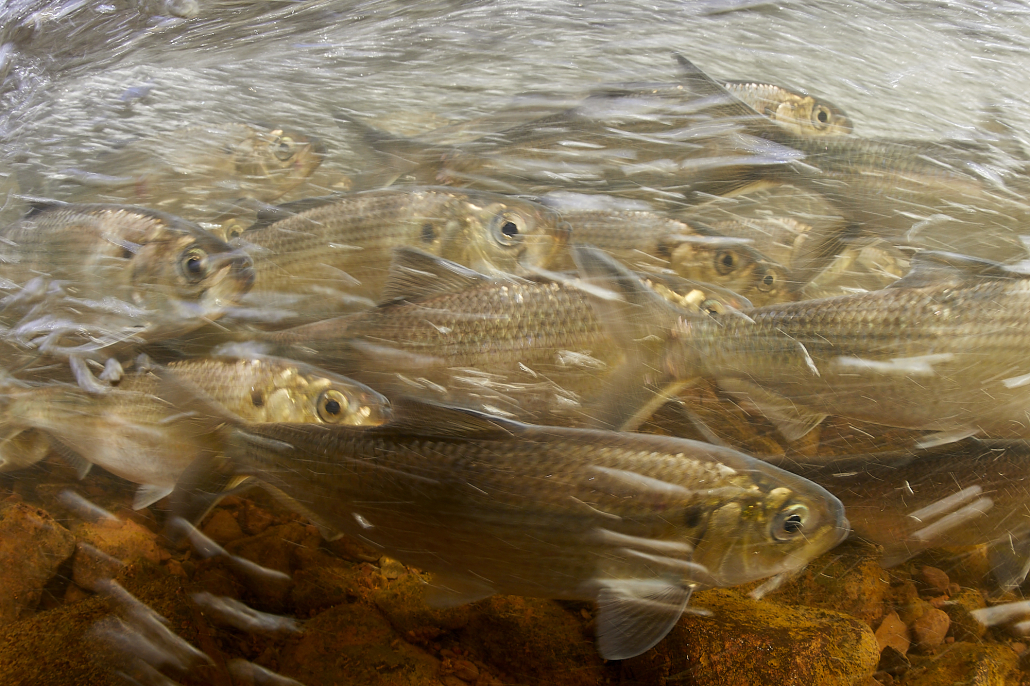5 Questions: AI and River Herring Monitoring with MIT Sea Grant-Funded Researcher Zhongqi Chen, Woodwell Climate Research Center

MIT Sea Grant provides competitive funding opportunities through our Core Request For Proposals (RFP) open to Massachusetts research scientists who seek to address marine issues in ways that benefit the Commonwealth.
We talked with funded researcher Zhongqi Chen about the project, Advancing an Underwater Video Fish Counting System with Deep Learning and Integration with Volunteer Visual Monitoring and PIT Tagging to Improve Fisheries Management and Population Assessments, a collaboration between MIT Sea Grant, the Woodwell Climate Research Center, and other partners.
Q 1: What fascinates you about fish like river herring?
Zhongqi Chen: “What fascinates me about river herring, and anadromous fish in general, is their migration between freshwater and the ocean, navigating incredibly complex life cycles that have persisted for millions of years despite environmental changes. In my earlier work with pacific salmon, I focused on how these fish respond to environmental stress, both physiologically and genetically. That interest in resilience and adaptation continues to inspire me. With river herring, my current focus is on population monitoring. Although their numbers have dramatically declined, they continue to return to rivers each year, demonstrating a strong drive to persist.”
“We want to understand that resilience and make sure these fish don’t disappear.”
Q 2: Who’s involved in this collaborative project?
Zhongqi Chen: “This is a highly collaborative project involving partners across research institutions and local organizations. At Woodwell Climate Research Center, I work closely with Dr. Linda Deegan, the lead principal investigator. Linda is a fish biologist with a deep interest in advancing river herring monitoring methods. Outside of Woodwell, we collaborate with MIT Sea Grant through Dr. Rob Vincent, and with Dr. Sara Beery, a professor at MIT specializing in biodiversity monitoring using computer vision. Rob has extensive experience in river herring monitoring and initiated this collaboration by applying for a grant to bring AI into the field of fish population monitoring.
We also work closely with local river management groups. On Cape Cod, we collaborate with the Coonamessett River Trust in Falmouth, MA, which leads community-based river restoration efforts and engages volunteers in the annual visual count of river herring. In Mashpee, we partner with the Natural Resources Department of the Mashpee Wampanoag Tribe, who have been managing the Santuit River site. They assist with camera setup, video review, fish counts, and part of the AI work in the project.
The third partner is the Ipswich River Watershed Association. They’ve been using video for river herring monitoring since 2015 but have relied on manual video review. We are now using their archived videos to train and test our AI models, with the aim of reducing manual labor and scaling up monitoring capacity.”
Q 3: How do volunteers contribute to this effort?
Zhongqi Chen: “Volunteers play a critical role in this project. During the river herring migration season, typically from March to June in Massachusetts, you’ll often see volunteers standing by the rivers, counting fish moving upstream. In many sites, this visual count activities have been going for over 20 years, providing invaluable data in monitoring river herring population. Because we can’t have human observers at the river 24/7, especially in bad weather or at night, AI helps fill those gaps. Even with the development of AI-based monitoring approaches, volunteer visual counts remain essential. Our goal isn’t to replace visual counts, but to improve upon them and provide a better solution for fish monitoring .
Beyond counting fish, we have volunteers assist with fieldwork, setting up and maintaining cameras, which is a demanding task. They also provide valuable qualitative observations, noting environmental conditions, bird activity, fish behavior, and water temperature, details that AI can’t easily capture.”
“Volunteers are still the backbone of this effort, and their contributions are irreplaceable. Their local knowledge, long-term commitment to river stewardship, and hands-on support in the field make this project not only possible, but far more effective.”
Q 4: How do you view AI as a tool in this field of work?

River herring migration beneath the surface of a Massachusetts river (Photo: Keith Ellenbogen, MIT Sea Grant Visiting Artist)
Zhongqi Chen: “AI is rapidly transforming many fields, and fish and wildlife monitoring is no exception. We’re seeing more researchers and resource managers exploring how AI can support conservation efforts, and I believe we’re just at the beginning of the new AI era. AI technology is evolving quickly, and staying current with the latest developments is essential.
“In our work, we’re constantly learning from the broader AI community, adopting new algorithms and refining our models to improve accuracy, reduce false positives and negatives, and enhance species identification. The goal is to build an AI workflow that can operate reliably in the complex, dynamic conditions of natural environments.”
“Fish and wildlife monitoring is a massive undertaking, spanning broad geographic regions and time scales, and we still lack the capacity to cover it all through traditional methods. My hope is that AI becomes a widely accessible tool in this field, especially within fisheries conservation. It has the potential to complement human efforts, expand monitoring coverage, and ultimately support better conservation outcomes.”
Q 5: What are the next steps and broader goals for this project?
Zhongqi Chen: “We’ve presented our work at several conferences. The level of interest has been very encouraging. One of the core goals of this project is technology transfer, developing an AI-based fish monitoring system that can be adopted and used by other groups working in fisheries management and conservation.
We’re currently collaborating with the Massachusetts Division of Marine Fisheries (DMF), whose river herring program covers 48 rivers and has relied predominantly on visual counting. DMF is now exploring how AI can be integrated into their monitoring workflow and is preparing to adopt this technology in the near future.”
“This kind of partnership shows how the technology we’re developing can be scaled and adapted to meet the needs of existing monitoring programs.”
“Ultimately, we want our experience and product to be useful not just for our team, but for other management agencies, NGOs, tribal fisheries, and local conservation groups working to monitor fish populations. Applying AI to solve real-world ecological problems is what makes this work truly impactful.”
Read more about this project and view all funded projects here. For the FY2026-2028 Core RFP cycle, MIT Sea Grant is focusing funding on several areas of research, including decarbonization of fisheries and the seafood industry, engineering for ocean uses, marine debris, ocean applications of biotechnology, and sustainable aquaculture.



